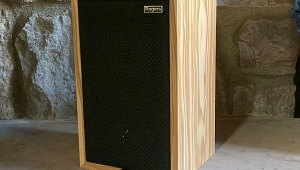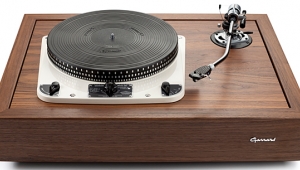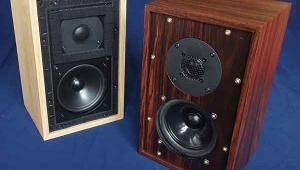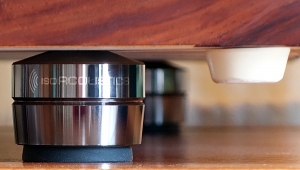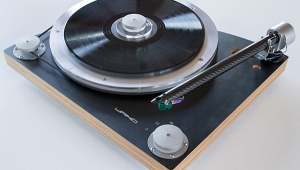| Columns Retired Columns & Blogs |
Listening #80 Page 2
But I wondered about the gear in my main system: Audio Note AN-E SPe/HE loudspeakers, Shindo Corton-Charlemagne mono amplifiers, Shindo Masseto preamplifier, and a tricked-out Thorens TD-124 turntable with EMT 997 tonearm. That system uses long speaker cables, too: a 6m (19.5') pair of Auditorium 23 copper. Granted, the Auditorium 23 cable, with its more pliant conductors and attractive green-fabric sheath, is easier to install and to live with than Naim's NACA5. On the other hand, at $2350 for that 6m pair, the Auditorium 23 speaker cable is considerably more expensive—though still far from the high-end "standard," I dare say.
Footnote 4: Miyajima Laboratory/Otono-Edison, 1-45-111, Katae 5-chome, Jounan-ku, Fufuoka, 814-0142 Japan. Web: www.miyajima-lab.com. US distributor: www.robyattaudio.com.
Again, I compared my $21 homemade RadioShack speaker cables with a more expensive pair. Again, there were small yet clearly audible distinctions, though of a sort different from those between the RadioShacks and the Naim NACA5s in my other system: more sonic than musical, and slightly more apparent.
And this time the distinctions made themselves known more in the top end than the bottom. Both cables communicated the musical essence of Louis Armstrong's voice throughout Classic Records' reissue of I've Got the World on a String (LP, Verve MG V 4035). But the RadioShack cables were audibly tizzier. Vocal sibilants were overcooked, and the same was true of the overtones of various acoustic instruments—the drone tanpura, and the initial click of the tabla—on the Beatles' "Within You Without You," from Sgt. Pepper's Lonely Hearts Club Band (LP, Parlophone PMC 7027). For its part, the more expensive Auditorium 23 stuff had more color and body and scale: Costlier sounded portlier, in a very good way.
Yet while the sound wasn't as pleasing as I might have liked, using the cheap cables in my Shindo system was more musically effective than having the same cheap cables in my other system. That's an important distinction: Ironically or not, I think I could live with the RadioShack wires in my Shindo system if I really had to. That's good to know, in case some thousand-dollar emergency crops up in the next year or two.
No better than RadioShack zipcord: You and I have heard that phrase billions of times, mostly from audio reviewers and high-end cable manufacturers—the two most trusted names in consumer electronics! Mostly we've used the phrase as a sort of negative benchmark, the way your parents tried to scare you into behaving by invoking the name of some notorious loser. Today, in the world of perfectionist audio cables, I think the gap between loser and overachiever is less extreme than we've worked ourselves into believing—and while the distinctions between various samples are quite real, their importance will vary from system to system and from listener to listener. As always, only you can determine that importance, along with your own internal value settings: Either the change is worth the expense (or, in the case of something like the Naim NACA5, the trouble) or it isn't. And remember: Anyone who tries to bully you into buying either a greater or a lesser cable than you think you need is a bigger fool than you'll ever be.
I cope sequentially
Noriyuki Miyajima is a Japanese record enthusiast who, at age 60, took the unlikely step of launching his own line of phono cartridges (footnote 4). That in itself deserves a certain amount of respect; more to the point, Miyajima has some noteworthy ideas about how to make a better moving-coil cartridge.
Confronted with the challenge of converting a moving series of bumps into a correlated pattern of movement within an electromagnetic generator, most of us would probably be content with any old bearing and lever that could trace the former with minimal wear, and still wiggle a coil of wire more or less as it should be wiggled. Yet when the bearing and lever are the stylus and cantilever of a tiny moving-coil pickup, there's more at stake than the mere mechanical consequences of getting things wrong. According to Noriyuki Miyajima, the location of the fulcrum about which that cantilever moves—and especially the fulcrum's position relative to the coil that the cantilever is hurtling this way and that—are of critical importance: If fulcrum and coil are too far from one another, he says, then the proportional distinctions within the continually variable output signal will be distorted and incorrect. So Miyajima created an altogether new kind of cantilever suspension, the cross-ring method, whereby the cantilever's fulcrum is centered precisely within the former on which the coil is wound.
At least I think that's the story. The Japanese-to-English translation software used in the creation of Miyajima's website gives his explanations a sufficiently fanciful tone that I can't be 100% sure. (Some of the more delightful turns of phrase: "I used obstinate, good wood for the body," "It is fixed through a rubber damper in York," and "It has a beautiful luster with a heavy tree.") Neither can I say for sure if the actual company name is Miyajima, Edison, Otono, or some combination of the three.
No matter: I've had the privilege of spending several months with Noriyuki Miyajima's top-of-the-line monophonic cartridge, the Premium Mono ($980), and it has proven to be more delightful than all the prose on his website put together.
This is mono for people who want a big, substantial sound, but who still want to hear all the instrumental lines as distinctly separate from one another as possible. The Premium Mono does all that—with force. It let me hear how physical Barney Kessel's chording is on Billie Holiday's Body and Soul (LP, Verve/Mobile Fidelity MFSL 1-247). And the timpani in the 1953 recording of Artur Rubinstein and the Chicago Symphony Orchestra under Fritz Reiner performing Brahms's Piano Concerto 1 (LP, RCA LM-1831) had similarly fine impact, while the piano's loudest moments were clean, forceful, and free from mistracking distortion. From Rubinstein to Gieseking to Lipatti to Richter, I couldn't find a single mono piano recording in my collection that could make the Premium Mono lose its grip on the groove.
My favorite version of Strauss's Don Juan, recorded in early 1954 by Wilhelm Furtwängler and the Vienna Philharmonic (LP, Electrola E 90 093), showed off the Premium Mono's excellent sense of scale; the instrumental voices in that one had fine, realistic color as well. "I've Just Seen a Face" and "Dizzy Miss Lizzy," from my mono copy of the Beatles' Help! (LP, Parlophone PMC 1255), sounded so good, and were so much fun, that I couldn't be bothered to write anything specific about them beyond this. Perhaps best of all, the 60-year-old recording of Bill Monroe's "Can't You Hear Me Calling," from The Classic Bluegrass Recordings, Vol.1 (LP, Columbia CCS-104), was tactile and, again, forceful—yet as subtle and eerie as it should be: Mac Wiseman's lead and Monroe's tenor vocals leapt from the mono mix with as much whipcrack presence as through my beloved EMT OFD 25. That's strong praise indeed.

And the Premium Mono's near-total rejection of surface noise was astounding: Throughout my time with it, only the most severe groove damage made itself known. I can't help wondering if the cross-ring system is even more suited to mono playback than stereo, inasmuch as it can be tuned to respond only to horizontal modulations, while ignoring vertical movement entirely. (As Miyajima's website puts it, "We deny an existing monaural cartridge so far!") Only the above-mentioned OFD 25, with its stiffly suspended, garden-tool–shaped cantilever, would seem to be in the same class.
Like the EMT OFD 25, the Miyajima Premium Mono was right at home in my high-mass EMT 997 tonearm. I installed the cartridge in my Yamamoto HS-1A accessory headshell and aligned it for use as a G-style pickup head; ie, with 50mm of space between the stylus tip and the headshell collet. Consequently, by moving the tonearm pivot to its rearmost position, I was able to take advantage of the 997 arm's full 325mm stylus-to-pivot distance, which contributed to its sure, imperturbable sound.
Unlike the OFD 25, it would seem that the Premium Mono can be used with more than just old-style removable-headshell tonearms: The modern SME Series V, Ikeda 345 and 407, various of the Helius/Audio Note arms, and perhaps even the Linn Ekos might also be candidates, not to mention discontinued but enduring arms such as the Zeta and the Fidelity Research FR-64s. But low-mass arms, such as my own Naim Aro—and even medium-low-mass arms, such as the Rega RB300 series—would seem insufficiently heavy: Like most of the cartridges in the Miyajima line, mono or stereo, the Premium Mono is a low-compliance device (though none of the others tracks quite as heavily as the Premium Mono's recommended downforce of 3.5gm).
Numbers don't lie, as the Woodies in our midst would have us know. For once, I agree, and the price tells the loudest truth of all: $980. For this kind of colorful, vibrant, impactful, and crazily noiseless mono replay, that's a staggering good value. More important, the Miyajima Premium Mono is the first cartridge I know of that offers a larger audience of contemporary analog enthusiasts the impact, color, and sheer juice of old-style pickup heads. A wonderful product!
Footnote 4: Miyajima Laboratory/Otono-Edison, 1-45-111, Katae 5-chome, Jounan-ku, Fufuoka, 814-0142 Japan. Web: www.miyajima-lab.com. US distributor: www.robyattaudio.com.
- Log in or register to post comments


